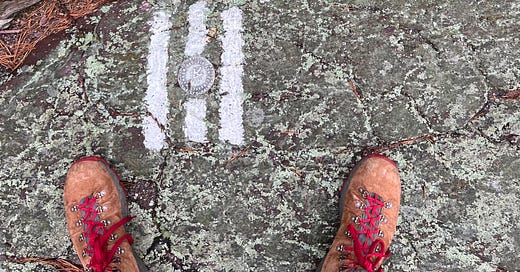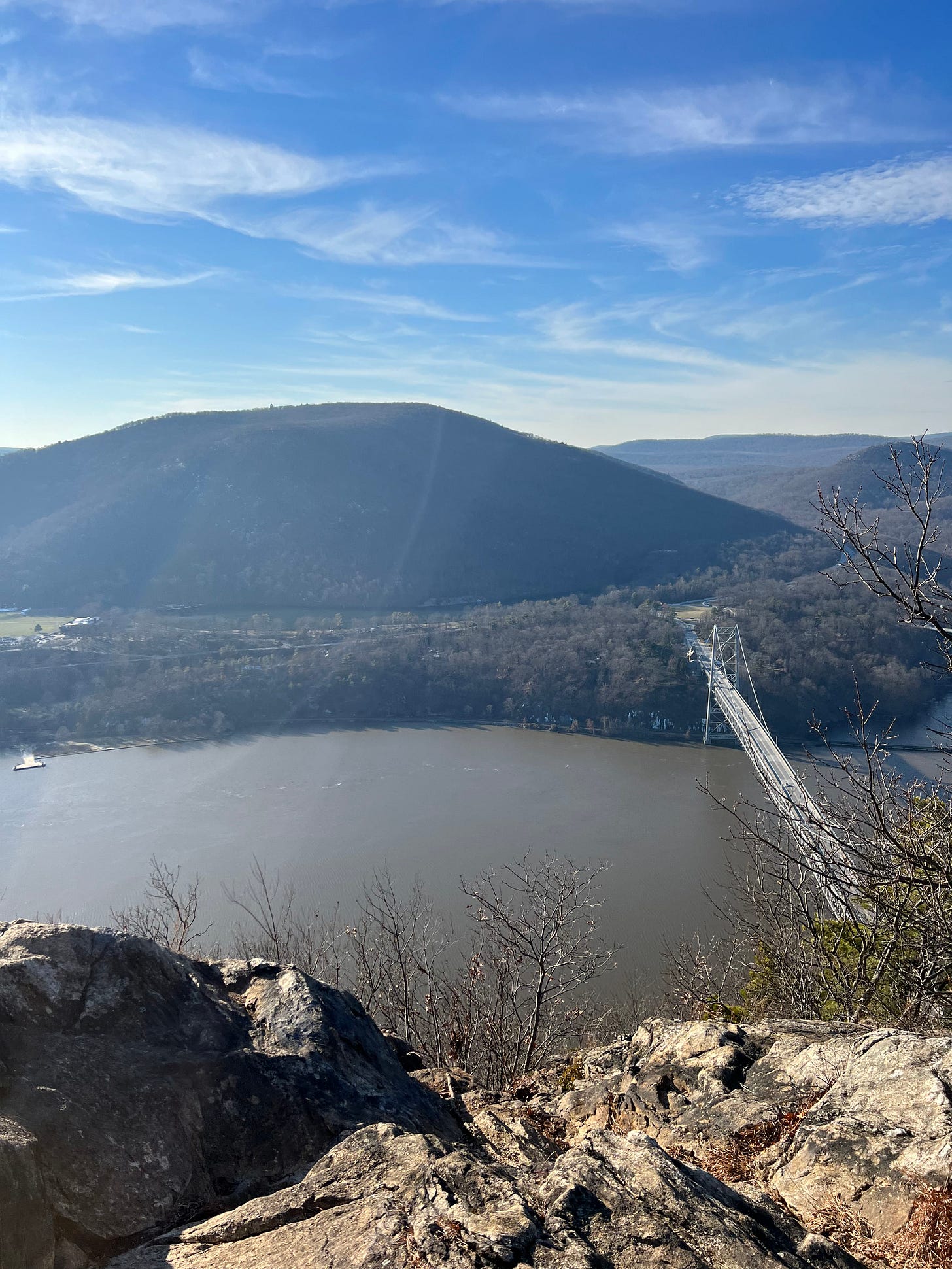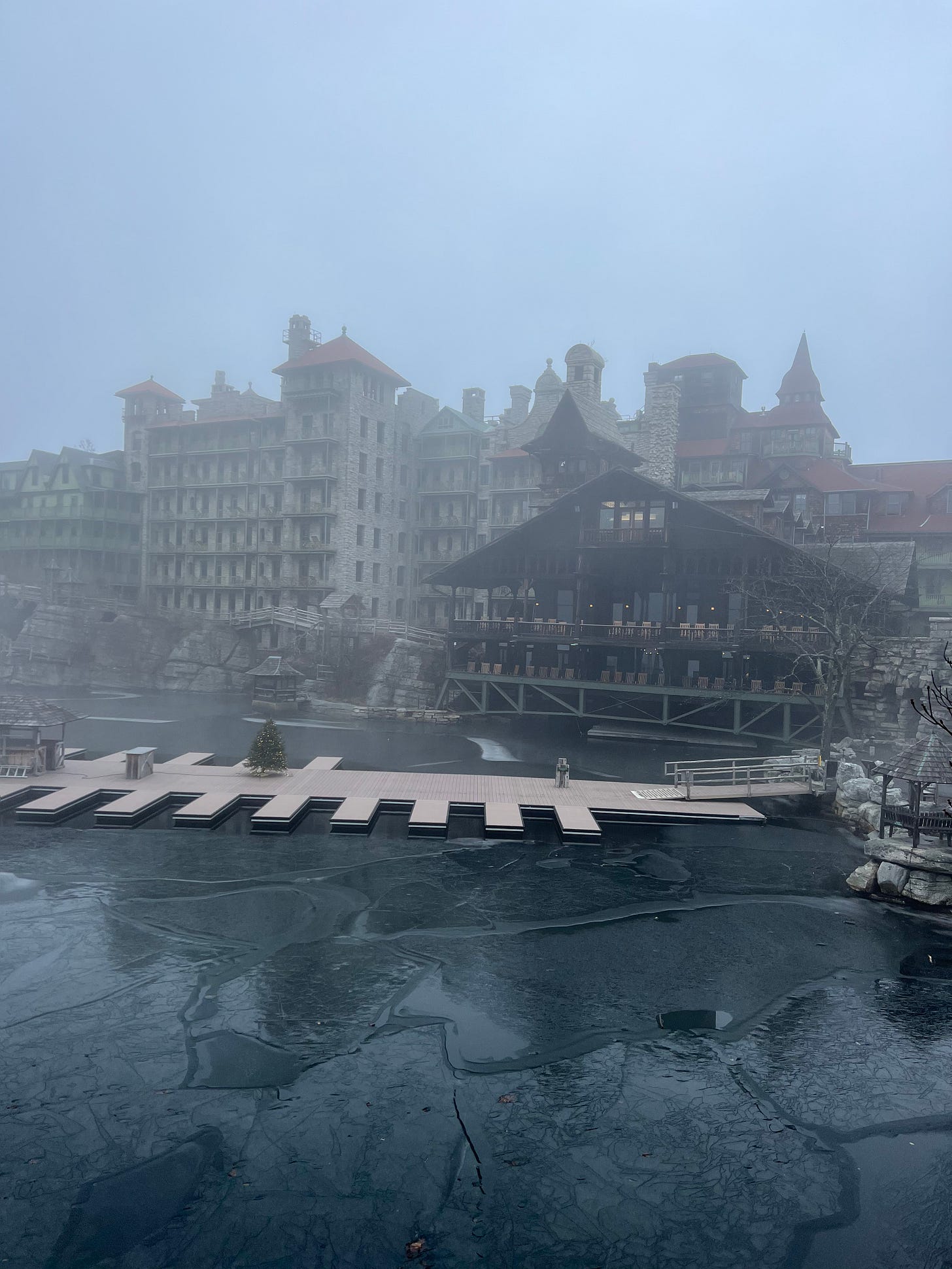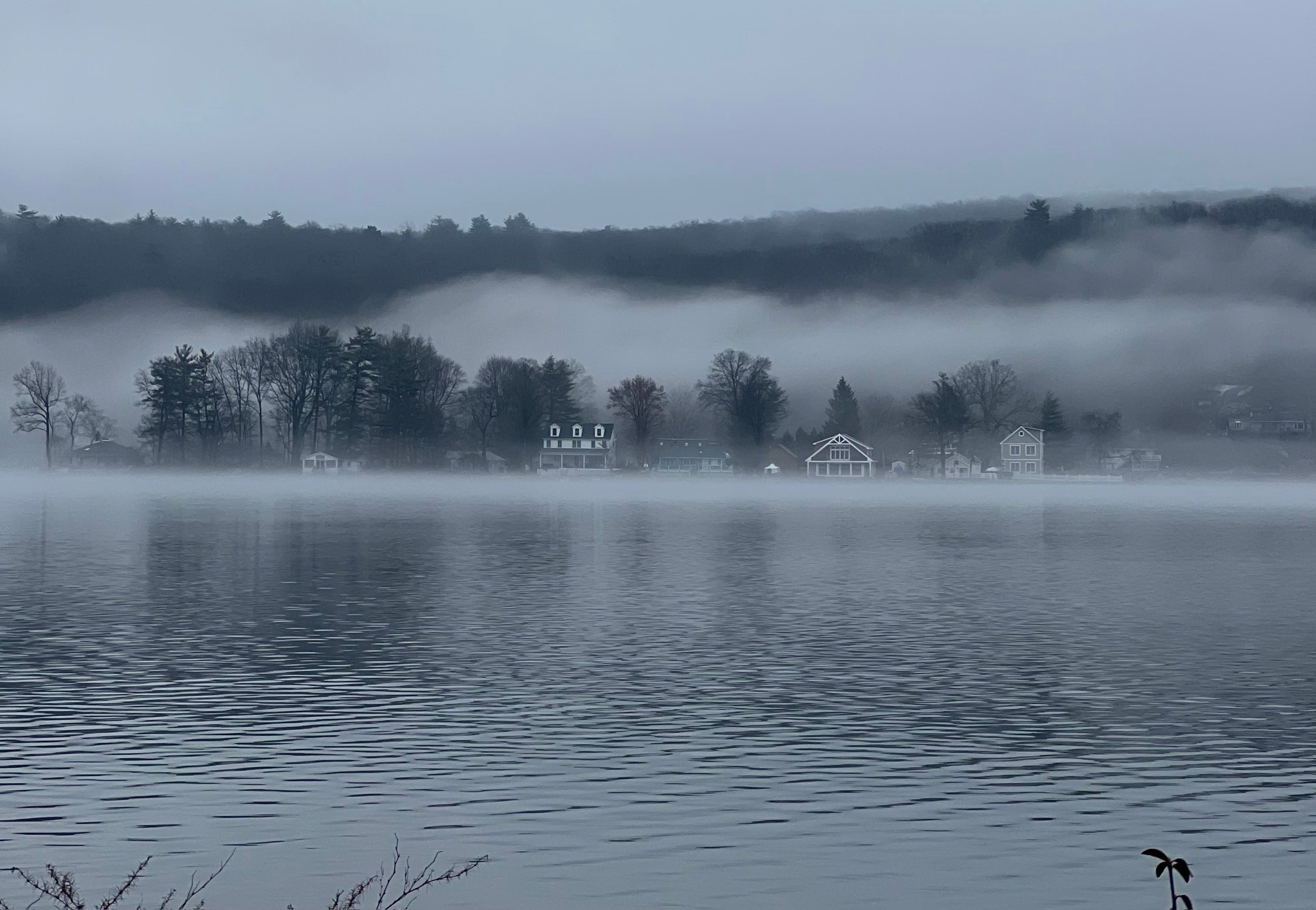EDITOR’S NOTE: This is Part II of the story. Before you read any further, make sure you’ve checked out Part I: Lightning, Burgers, Castles and Bears.
I looked down to the rock where the short white lines had been painted. A tiny silver medallion — with a T inside an A — had been anchored into the stone. I positioned my feet just so. One boot in New Jersey, the other in New York.
Driving along the western edge of Greenwood Lake, I marveled as I looked out to Fox Island, a tiny slip of land with houses dotting its shore, boat garages opening directly onto the water. I was looking for the Greenwood Lake Marina, which was opposite the trailhead for the Surprise Lake Loop, a track promising stunning views of Greenwood, its island — Fox, Storms and Chapel — and the surrounding forests. One of those, the Sterling Forest State Park, I’d been to previously, running the full perimeter around Sterling Lake. This was my first visit to Greenwood, which I’d first learned about from my dad. Maybe half a century ago, he used to come here with his brothers and, as I recall, drive around on a small boat. On this trip, there’d be no boating. But, perhaps, if I was lucky, I’d glimpse the skyline of New York City while out on my hike.
The Surprise Lake Loop was, for me, the perfect hike. Views. Scrambles. And abundant water features. It feels like the trail is made of 90 percent rock — but only a fraction of it is true scrambles. These scrambles were fun, challenging, exciting — not potentially deadly like the one I’d encountered at Bonticou Crag. There was one point, early on, where I had to get down on my hands and knees to negotiate the slick, moss-covered rock. Once I was back on my feet, I looked out at the rock ridge line and realized it looked almost exactly like where I’d been standing atop Bonticou.
The trail carries you past the eponymous Surprise Lake, which is remote, impossibly quiet and beautifully calm. I could see vestiges of melting ice out on the water, fog floating peacefully over the far shore. It was just so stunningly silent. After enjoying the view, I stopped on a rock and turned back to listen as Cooley Brook babbled by.
Next, you take a right turn off the main trail, following the stone path through the trees to a lookout point high above West Pond — its shores inaccessible, guarded entirely by the forest. If you follow the loop on AllTrails, you’ll be done in 4.4 miles. But I was taking a detour. For the second time in as many weeks, I was picking up a thread of the Appalachian Trail.
There were three Servpro vans sitting outside the entrance to the Bear Mountain Inn on a sunny Wednesday morning at the end of December when Allison and I pulled up. Originally, we intended to stay at the iconic inn for New Year’s Eve, but that plan was foiled when a water main broke — shutting down the hotel indefinitely, as telegraphed by those giant green vans from the water restoration and cleanup company.
The hotel was out of service, but the surrounding trails — complete with sweeping Hudson River views — were not. So, instead of stopping by Bear Mountain at the end of what was to be a five-day trip into the Hudson Valley, we paid a quick visit on the way up. Setting out from the Bear Mountain parking lot, we immediately stepped onto the Appalachian Trail, which runs past Hessian Lake, and followed it across the Bear Mountain Bridge, spanning high above the Hudson. It’s incredibly cool to cross the bridge but you always feel wildly exposed. I always hold onto my hat to make sure it doesn’t fly off into the river 153 feet below.
We looked up to Anthony’s Nose — rising 900 feet above the Hudson — which we were about to climb. It was the start of eight hikes, runs and scrambles through the woods of New York and New Jersey.
A day later we’d settled into our hotel in New Paltz, an ideal base camp for excursions into the Shawangunk Mountains and a remarkably charming, if quirky, Hudson Valley town.
When I sat down to write this, I was excited to unfurl a brief history of this town that I enjoy visiting so much. But, I should have realized that the story is quite grim. New Paltz was founded in 1677 by a band of French Huguenots who arrived in what was then the Dutch colony of New Netherland by way of Germany. After fleeing religious persecution in France and making a stopover in Palatinate (the German region where the New Paltz name comes from), the Huguenots purchased a patent for 40,000 acres of land from a Lenape tribe known as the Esopus. This transaction came on the heels of the Esopus Wars, in which the Dutch settlers triumphed over the local tribe. The conflict — both the warfare and the attendant disease — shattered the Esopus. It was the beginning of the end. The Esopus were pushed first to Western New York and later to Wisconsin.
One day in town, I walked along Historic Huguenot Street, a 10-acre National Historic Landmark District tucked along the edge of the Wallkill River. With seven stone houses, a reconstructed 1717 church and an original graveyard with tombstones dating back to 1690, it almost feels like you’ve been dropped into the old village over 300 years ago. There’s even a replica of an Esopus wigwam.
On another day, we followed Main Street out of the village, over the Wallkill, past the farmlands and up into the mountains. Hiking through the snow of Minnewaska State Park Preserve, we learned the hard way about the perils of attempting rock scrambles covered in sheets of ice without the benefit of microspikes. I made it to Lake Awosting, one of three sky lakes in the preserve, blanketed with ice and snow. I explored the ranger’s cabin on its shores — abandoned until spring.
Now equipped with microspikes, we hiked up to the Mohonk Sky Top Tower for the second time in as many winters and ate lunch on the side of the frozen lake. While we sat in a gazebo, the fog rushed past, revealing the facade of the Mohonk Mountain House — as impressive of a lakeside resort as you’ll ever see. Back in town, I stopped by Inquiring Minds. A year prior, I’d walked into the delightful bookstore where I’d stumbled across Walking The Hudson, in which Cy Adler, the author, conservationist, organizer and professor (of oceanography, physics and math) narrates the journey, by foot, from the Battery — Manhattan’s southern-most point — to Bear Mountain. It was the book that introduced me to the Shorewalkers, the environmental, non-profit that Adler founded, and the Great Saunter, the organization’s annual, 32-mile hike around the island of New York. Without that book, I would have never completed that adventure (in a rainstorm, no less) or started this Substack. It’s difficult to overstate the book’s impact on my life. Combing through the shelf of books of local interest, I was disappointed to see Walking The Hudson was nowhere to be found. I couldn’t help but wonder how differently things would have turned out if it had also been out of stock the winter before.
Nearly every night in New Paltz, we ate, and drank, at P&G’s — a restaurant and bar I cannot recommend highly enough. On the final day, we took the Shawangunk Mountains Scenic Byway out of town, glimpsing the Catskills up north before dropping down into New Jersey and eventually Morristown.
In Morristown — which was known as the military capital of the Revolutionary War, owing to its strategic location between Philadelphia and New York City, the latter of which the British had captured — I soaked up the history and the outdoors. I ran through Loantaka Brook Reservation, the first of General George Washington’s winter camps in the area. I also ran through Jockey Hollow, the more famous of the two encampments, where approximately 10,000 troops stayed during the winter of 1779-80 in little log huts they built themselves.
It sounded, well, miserable. Aside from being, perhaps, the most severe winter on record in the Northeast, there was no food.
“I saw several of the men roast their old shoes and eat them,” wrote a private from the Connecticut Brigade, in a letter preserved by the Morristown National Historic Park.
Washington, meanwhile, wintered in the nearby Ford Mansion. Both the general’s lodgings and replicas of the little wood huts can be toured today.
At 12:31 p.m. — after leaving West Pond behind and just before I wandered into New York — I found the white blaze I had been looking for.
I’d made it to the Appalachian Trail, which briefly coincided with the Surprise Lake Loop. Instead of following the path back toward Greenwood Lake and the trailhead, I continued north, so I could walk along one of the most famous tracks in the world for as long as I saw fit.
The literal border between New Jersey and New York is marked in white paint on the stone trail. An “NY” on one side of the white line, an “NJ” on the other. I was getting tired and was just about ready to turn back, but I kept pressing forward, hoping that I’d find a high point, as my Strava map suggested, to take in the view.
Inexplicably, just ahead of me on the ridge line, I saw an American flag rippling in the wind. I didn’t know it at the time, but this was the marker for Prospect Rock, which at 1,433 feet is the highest point along the Appalachian Trail in New York. The flag was held aloft by a giant wooden stick, maybe 12 feet tall, that had somehow been fastened into the rock. On a clear day, I would have been treated to sweeping views of Greenwood Lake, the long, narrow body of water that runs seven miles, starting in New Jersey and stretching into New York. If I was lucky, I might have even seen the distant towers of New York City. Instead, I settled for a shrouded view of the lake. I wasn’t quite high enough up to see cleanly over the trees, but I could spy a tiny island out on the water.
I was sad as I neared the end of the loop. This was the last hike, the end of the adventure. I had to remind myself that there will be more exploring to be done.
All that’s left to do, I thought, as I made my way down the moss-covered rocks which had been incredibly slick all day, Was to slip and fall. And, seconds later, it happened. I stepped onto a rock just like all the others. Before I knew what was happening, both feet slipped out from under me. The wet rock had effectively transformed into a slide. My left wrist and elbow took the worst of it as I landed in a bed of mud and wet leaves.









